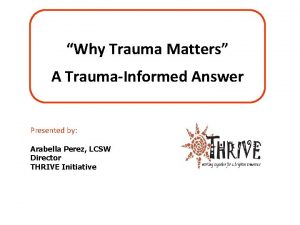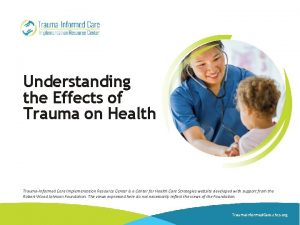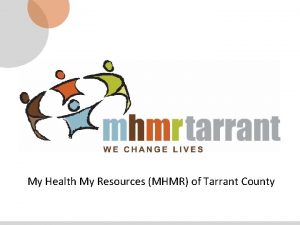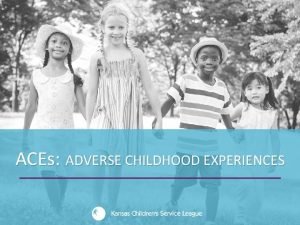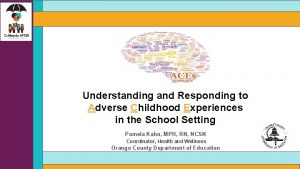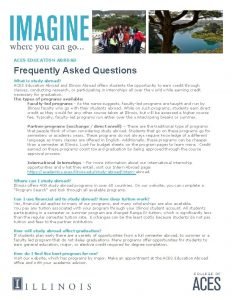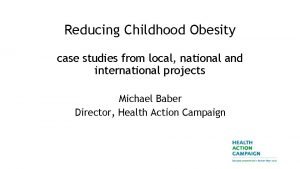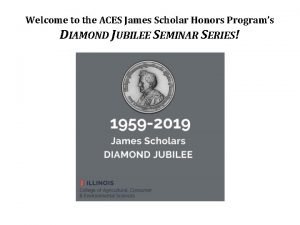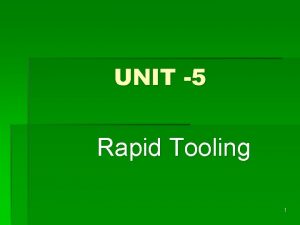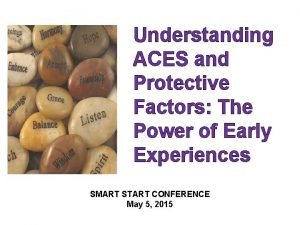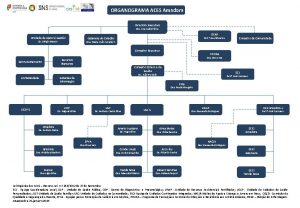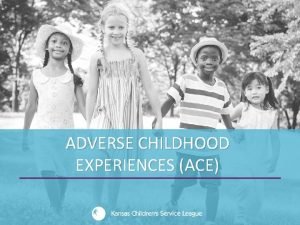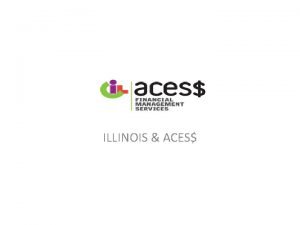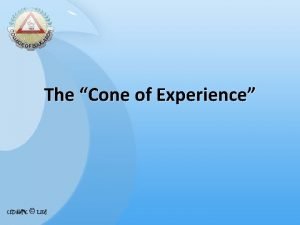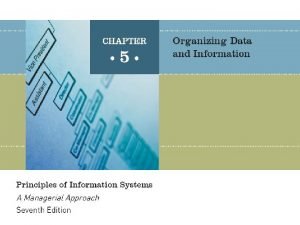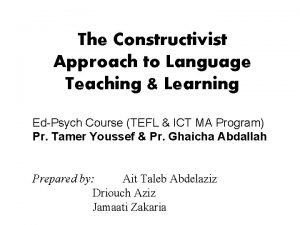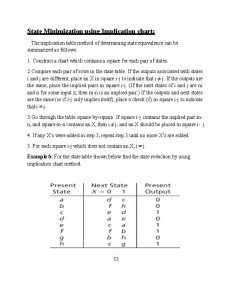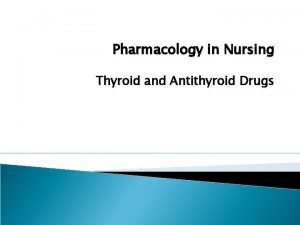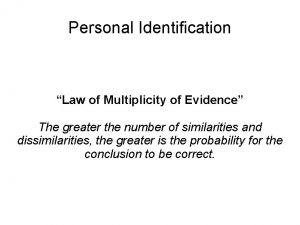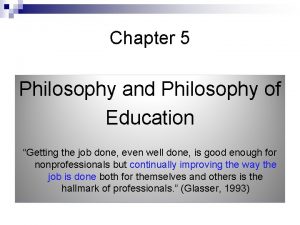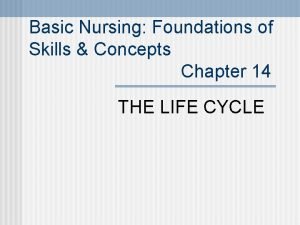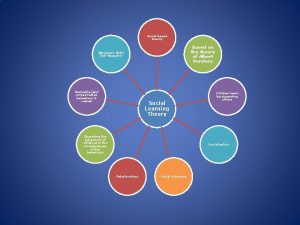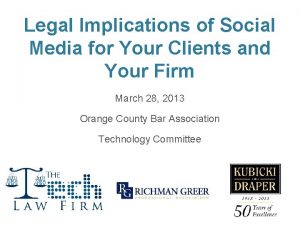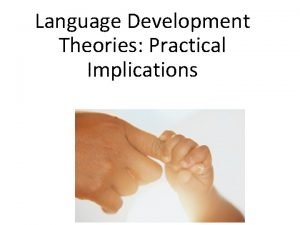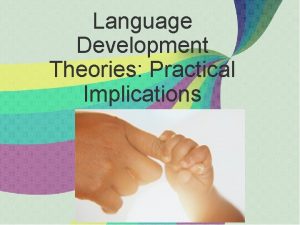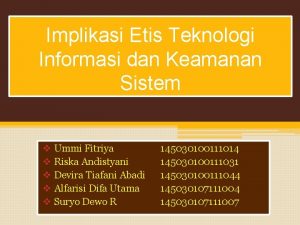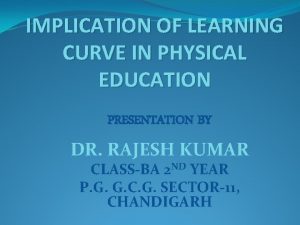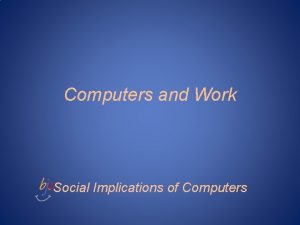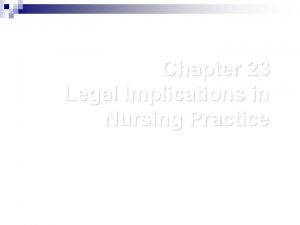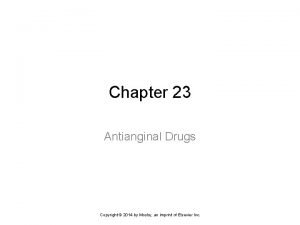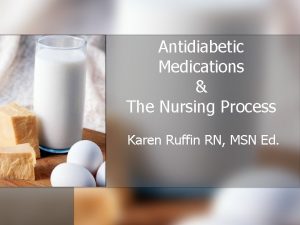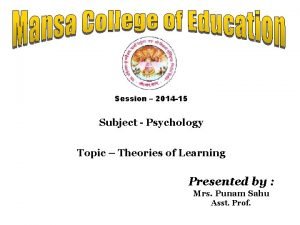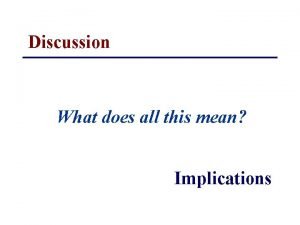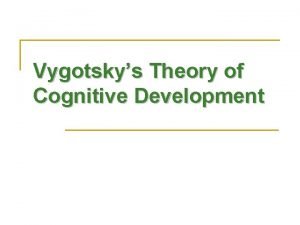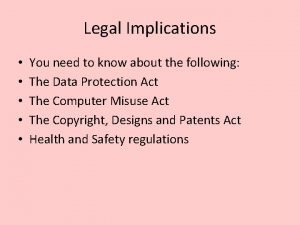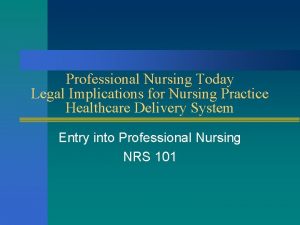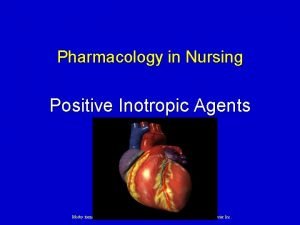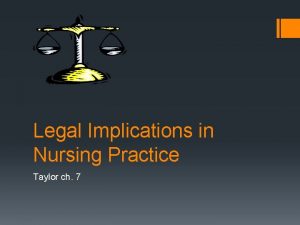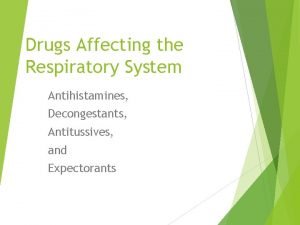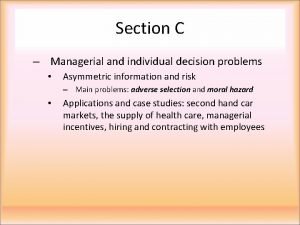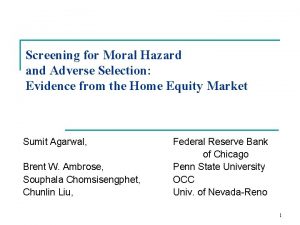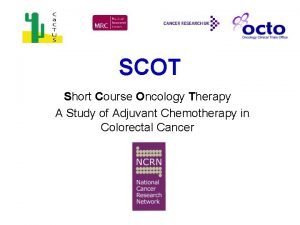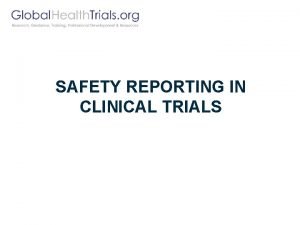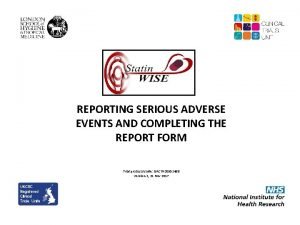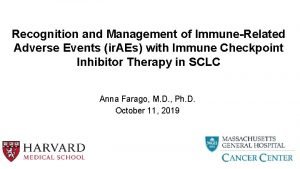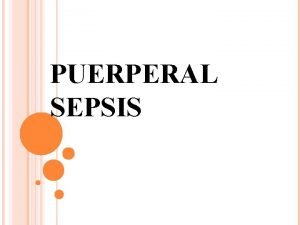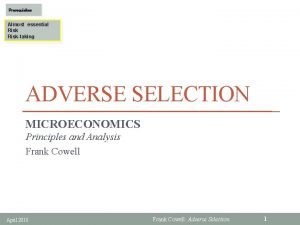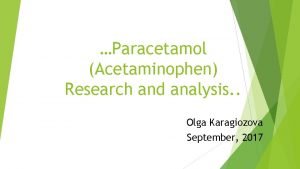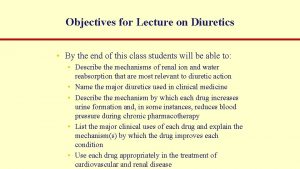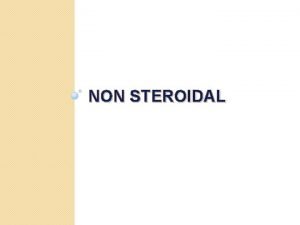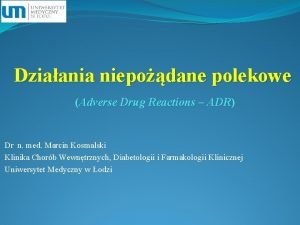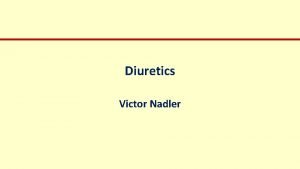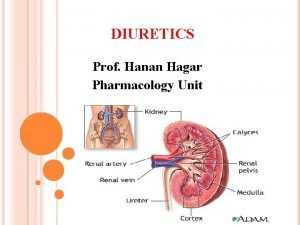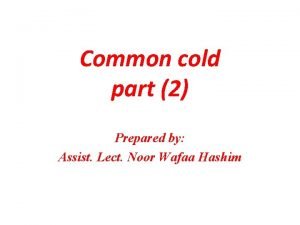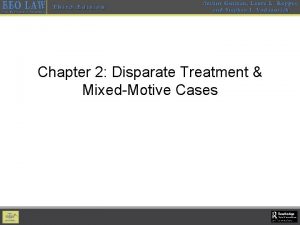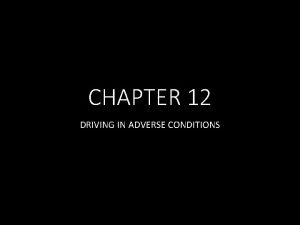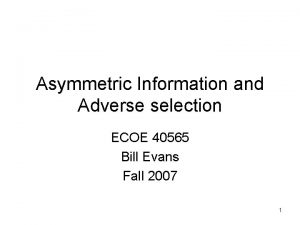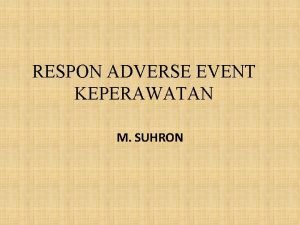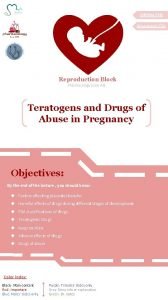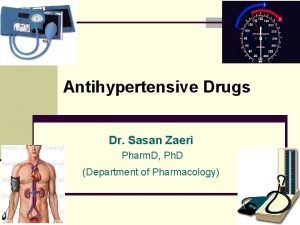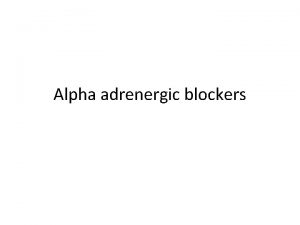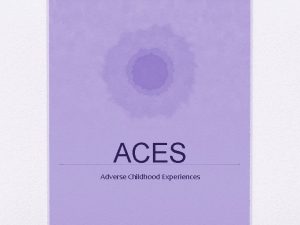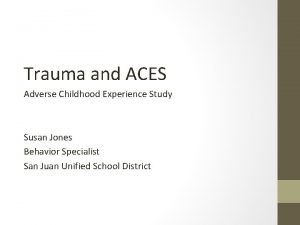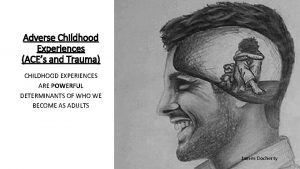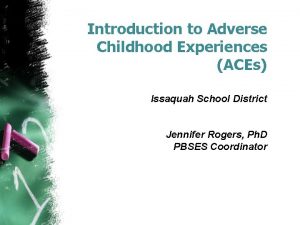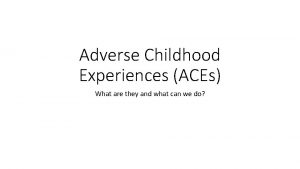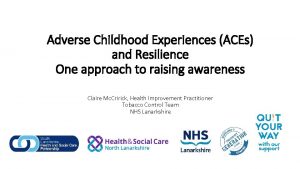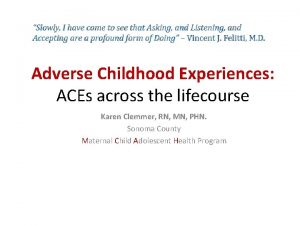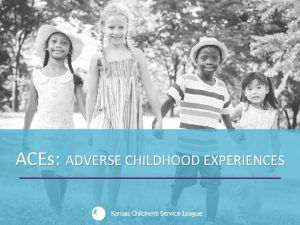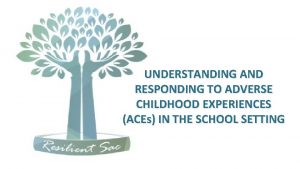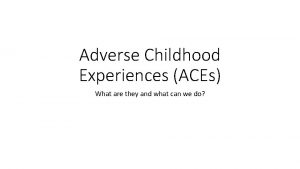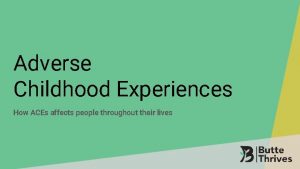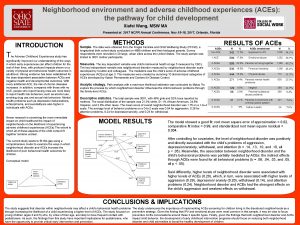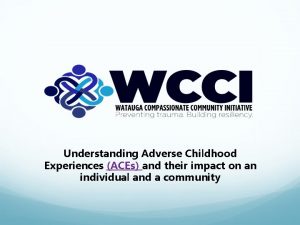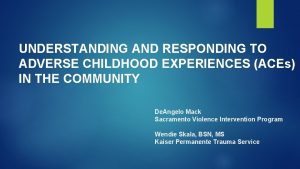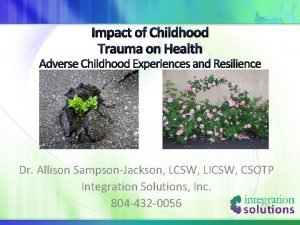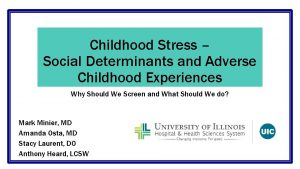THE ADVERSE CHILDHOOD EXPERIENCE STUDY ACES IMPLICATIONS OF


























































































- Slides: 90

THE ADVERSE CHILDHOOD EXPERIENCE STUDY (ACES): IMPLICATIONS OF LONGTERM EFFECTS Randell Alexander MD Ph. D University of Florida – Jacksonville

USEFUL FOR NOW, BUT THESE NEED TO GO AWAY • • CPS CPT system Trauma informed communities DV shelters • Need to prevent all of this instead!!

SAVE THE BRAIN – PREVENT ABUSE GROW THE BRAIN - STIMULATION Brains need both: 1. Freedom from abuse 2. Positive stimulation

Left Behind By Kindergarten: Children living in poverty average 15 IQ points below their peers. Vocabulary at Age 3 Poor children: 525 words Working class: 749 words Professional: 1, 116 words By age 4, the average child in a poor family might have been exposed to 13 million fewer words than child in a working class family and 30 million fewer words than a child in a professional family. 4

The Evolution of Prevention What Kind of Problem is it? Justice & Social Service Problem Public Health Problem “It is time for critical thinking to formulate a new national public health priority, preventing child maltreatment and promoting child well treatment. ” Surgeon General Richard H. Carmona, MD MPH – March 2005

Lifetime Economic Burden of Child Maltreatment: $124 billion in 2008 Productivity losses Health care costs Special education costs Criminal justice costs Child welfare costs (Fang X, et al. Child Abuse Negl (2012) 6

WHAT HAPPENS IF WE DON’T PREVENT ABUSE? FOUR AREAS OF RESEARCH CONVERGENCE ACES STUDY BRAIN IMAGING NEUROSCIENCE TELOMERES

#1

ACES

The Influence of Child Maltreatment Throughout Life Health-risk Behaviors Sexual promiscuity Sexual perpetration Alcohol abuse Illicit/injected drug use Smoking Behavior problems Child Maltreatment Mental/Social Problems PTSD Depression Anxiety Eating disorders Academic achievement Unwanted pregnancy Obesity Revictimization Disease and Injury Conditions Ischemic heart disease Diabetes Stroke Cancer Suicide Skeletal fractures Chronic bronchitis/ emphysema STDs (e. g. , HIV) Hepatitis

Adverse Childhood Experiences and their Relationship to Adult Health and Well-being A collaborative effort of Kaiser Permanente and The Centers for Disease Control and Prevention www. acestudy. org Vincent J. Felitti, M. D. Robert F. Anda, M. D.

The Adverse Childhood Experiences (ACE) Study Stud • The largest study of its kind ever done to examine the health, social, and economic effects of adverse childhood experiences over the lifespan (18, 000 participants) • Average = 57 years old

What do we mean by Adverse Childhood Experiences? Experiences that represent medical and social problems of national importance. -childhood abuse and neglect -growing up with domestic violence, substance abuse or mental illness in the home, parental loss, or crime

Categories of Adverse Childhood Experiences Category Prevalence (%) Abuse, by Category Psychological (by parents) Physical (by parents) Sexual (anyone) 11% 22% Household Dysfunction, by Category Substance Abuse 26% Mental Illness 19% Mother Treated Violently 13% Imprisoned Household Member 3%

ACE Score • Total number of ACE that each participant reported • Used to assess negative experiences during childhood • Example: Experiencing physical abuse as a child is an ACE score of one. Experiencing physical abuse plus witnessing IPV is an ACE store of two.

Adverse Childhood Experiences Score Number of categories of adverse childhood experiences are summed … ACE score Prevalence 0 48% 1 25% 2 13% 3 7% 4 or more 7% • More than half have at least one ACE • If one category of ACE is present, there is an 84% likelihood of additional categories being present.

HEALTH CONSEQUENCES

SEX

Number of Adverse Childhood Experiences and Teen Sexual Behaviors

ACE Score and HIV Risks

DRUGS

Childhood Experiences vs. Adult Alcoholism 4+ 3 2 1 0

Relationship Between Number of Adverse Childhood Experiences and Smoking Behaviors and Smoking-Related Lung Disease

ACE Score vs. Intravenous Drug Use N = 8, 022 p<0. 001

Estimates of the Population Attributable Risk* of ACEs for Selected Outcomes in Women *That portion of a condition attributable to specific risk factors

MENTAL HEALTH

Childhood Experiences Underlie Chronic Depression

Childhood Experiences Underlie Attempted Suicide 4+ 3 2 0 1

ACE Score and Hallucinations Ever Hallucinated* (%) Abused Alcohol or Drugs ACE Score *Adjusted for age, sex, race, and education.

Estimates of the Population Attributable Risk* of ACEs for selected outcomes in women *That portion of a condition attributable to specific risk factors

Childhood Experiences Underlie Rape 4+ 2 1 0 3

ACE STUDY FINDINGS • As ACE score goes up, so does risk for: – – – Smoking Organic disease Adult alcoholism Depression and suicide attempts Having 50+ lifetime sexual partners STD’s and Rape (from 5% to 33%) Hallucinations Domestic Violence Addictions Dying early Job Problems and lost time from work Felitti VJ, Anda RF, Nordenberg D, Williamson DF, Spitz AM, Edwards V, Koss MP, et al JS. The relationship of adult health status to childhood abuse and household dysfunction. American Journal of Preventive Medicine. 1998; 14: 245 -258.

Adverse Childhood Experiences Reported by Adults Five States, 2009 • First published report to document prevalence of ACEs in population-based representative sample from multiple states stratified by demographic characteristics, including sex, age, education, and race/ethnicity. • Approximately 59% reported one or more ACEs • These BRFSS estimates are similar to the findings in the Kaiser -CDC ACE study (2) and similar research, including study in Texas CDC MMWR, December 17, 2010/59(49); 1609 -1613

Adverse Childhood Experiences determine the likelihood of the 10 most common causes of death in the US Top 10 Risk Factors: smoking, severe obesity, physical inactivity, depression, suicide attempt, alcoholism, illicit drug use, injected drug use, 50+ sexual partners, history of STD

With an ACE Score of 0 The majority of adults have few, if any, risk factors for these diseases

However, with an ACE Score of 4 or more The majority of adults have multiple risk factors for these diseases or the diseases themselves

Many chronic diseases in adults are determined decades earlier, in childhood

Evidence from ACE Study Adverse childhood experiences are the most basic cause of * health risk behaviors * morbidity * disability * mortality * healthcare costs

ACES AND PREVENTION

Frieden’s pyramid adapted to child maltreatment Smallest Impact Greater effort Examples Parent training Counseling & Education Screen and refer for IPV, depression or substance abuse Clinical Interventions Home visitation Child-Parent Centers Long-lasting protective interventions Smaller Effort Largest Impact Changing the context Make healthy choices the “default” or easiest choice Built environment Positive Community Norms Poverty, education, Socioeconomic Factors Frieden’s pyramid AJPH 2010; 100(4): 590 -595 housing, inequality

Assuring safe, stable, nurturing relationships and environments for all children Vision for DVP’s Child Maltreatment Prevention Work

SOCIAL NORMS CHANGE

OPPORTUNITY FOR NORMS CHANGE: CORPORAL PUNISHMENT • Adrian Peterson – NFL • Sparking a debate about corporal punishment in USA • Is your organization reaching out to NFL? • AVA is trying

• OPPORTUNITY FOR NORMS CHANGE: CORPORAL PUNISHMENT In the following 38 countries, children are protected by law from all corporal • Bolivia (2014) • • Brazil (2014) • Honduras (2013) • TFYR Macedonia (2013) • South Sudan (2011) punishment (most recent first): Malta (2014)

OPPORTUNITY FOR NORMS CHANGE: CORPORAL PUNISHMENT • Albania (2010) • Luxembourg (2008) • Congo, Republic of (2010) • Republic of Moldova (2008) • Kenya (2010) • Costa Rica (2008) • Tunisia (2010) • Poland (2010) • Togo (2007) • Liechtenstein (2008) • Venezuela (2007) • Spain (2007)

OPPORTUNITY FOR NORMS CHANGE: CORPORAL PUNISHMENT • Turkmenistan (2002) • Uruguay (2007) • • Portugal (2007) New Zealand (2007) • Netherlands (2007) • Greece (2006) • Hungary (2005) • Romania (2004) • • Ukraine (2004) Iceland (2003) • • Germany (2000) • Bulgaria (2000) • Croatia (1999) • Latvia (1998) • Denmark (1997) Israel (2000)

OPPORTUNITY FOR NORMS CHANGE: CORPORAL PUNISHMENT • Cyprus (1994) • Austria (1989) • Norway (1987) • Finland (1983) • Sweden (1979)

ACE Score and Work Problems Job Problems



NEW ZEALAND SOVEREIGN INSURANCE

IMAGINE if……. . More employers offered on-site childcare and/or childcare benefits To help reduce parental stress and allow parents to check in during day

IMAGINE If……. . Businesses helped reinforce prevention messages……. With “floor talkers” on coping with infant crying

IMAGINE if…… When business leaders talk with policy makers, they use the opportunity to talk about the impact of ACEs and the importance of safe, stable, nurturing relationships and communities

#2

BRAIN DEVELOPMENT National Scientific Council on the Developing Child www. developingchild. net Some of the top neuroscientists have also come to appreciate how brains: 1. Develop, and 2. Develop differently depending upon the environment they are exposed to

3 CATEGORIES OF STRESS • Positive stress • Tolerable stress • Toxic stress

3 Core Concepts in Early Development • Experiences build brain architecture • “Serve and Return” interaction shapes brain circuitry • Toxic stress derails healthy development http: //www. developingchild. harvard. edu

BRAIN DEVELOPMENT • Early experiences are built into our bodies and brains--- for better or for worse • Healthy development in the early years provides the building blocks for: – – – educational achievement economic productivity responsible citizenship lifelong health strong communities successful parenting of the next generation http: //www. developingchild. harvard. edu

Synaptic Density 700 new synapses (neural connections) every second SOURCE: Harvard Center on the Developing Child

Brain activity of a normal five-year-old child (left) and a five-year-old institutionalized orphan neglected in infancy (right).

SSNRs : Influence Early Brain Development and Buffer Adverse Childhood Experiences l Healthy development depends on the quality and reliability of a young children’s relationships with the important people in their lives l Nurturing, responsive, and individualized interactions build healthy brain architecture that provides a strong foundation for future learning, behavior, and health l SSNRs can provide a buffer for ACE

#3

SEXUAL ABUSE AND THE BRAIN • Children may be more susceptible than adults to cellular microenvironments and impact on brain development • High rate of PTSD (42% to 90%) • [Physical abuse rate of PTSD may be 50%] • Limbic-hypothalamic-pituitary-adrenal axis is at risk (may be “over sensitive”) De Bellis, M. Spratt E, Hooper S. Neurodevelopmental Biology Associated with Childhood Sexual Abuse. JCSA 2011.

SEXUAL ABUSE AND THE BRAIN • Increased sensitivity of the locus ceruleus/SNS/chatecholamine system? • Responsible for high heart rate, blood pressure, other effects • Becomes dysregulated?

SEXUAL ABUSE AND THE BRAIN • Serotonin may become low in the prefrontal cortex – associated with depression, suicidal behaviors, impulsivity • May lead to “learned helplessness”

SEXUAL ABUSE AND THE BRAIN • Neuroimaging of adults supports the concept that medial prefrontal regions responsible for executive functions are hyporesponsive when abused as children • Amygdala is hyperresponsive • Corpus callosum is decreased (males more than females? ) • Smaller overall brain volume (e. g. 8%) as adults

#4

TELOMERES • Telomeres are the ends of DNA strands which are shortened with each cellular division. • With each replication, telomeres shorten until the “Hayflick limit” is reached and the cell enters senescence. • Telomeres are thought to be a sign of cellular aging (and perhaps overall aging of the organism).

EXPOSURE TO VIOLENCE DURING CHILDHOOD IS ASSOCIATED WITH TELOMERE EROSION FROM 5 TO 10 YEARS OF AGE: A LONGITUDINAL STUDY • Same children examined for telomere erosion between 5 and 10 years of age • Physical abuse caused more erosion • Combination of physical abuse, exposure to domestic violence, or bullying caused the most erosion • Children will have decreased life span, earlier diseases Shalev I, Moffitt TE, Sugden K, Williams B, Houts RM, Danese A, Mill J, Arseneault l, Caspi A. Molecular Psychiatry 2012. doi: 10. 1038/mp. 2012. 32.

FOUR LINES OF CONVERGENCE • Not only does abuse alter which neurons are selected, how different parts of the brain develop, and how neuro-hormonal pathways are altered but now it can be seen that it leaves its very footprints deep in the cells. • Abuse creates different children

EPIGENETICS • Epigenetics is the study of heritable changes in gene activity that are not caused by changes in the DNA sequence

ADULTS TELL YOU ABOUT THEIR BRAINS

ADULTS TELL YOU ABOUT THEIR BRAINS • How people react gives you clues about their life

ADULTS TELL YOU ABOUT THEIR BRAINS • Example 1: – A guy goes into a bar and gets into a discussion with another guy – That guy suddenly hits him without warning • What kind of brain behavior is he showing? • Limbic-hypothalamic-pituitary-adrenal overreactivity?

ADULTS TELL YOU ABOUT THEIR BRAINS • Example 2: – A woman says that her 3 year old will not mind and she needs to hit him, but it doesn’t work – You give alternatives, but she insists nothing works and doesn’t really try • What kind of brain behavior is she showing?

CHILDREN TELL YOU ABOUT THEIR BRAINS

CHILDREN TELL YOU ABOUT THEIR BRAINS • They experience trauma – Prenatal substance exposure, mother’s stress chemicals – Neglect – Physical abuse – Sexual abuse – Witnessing IPV, bullying

Response to Trauma: Bodily Functions FUNCTION CENTRAL CAUSE SYMPTOM(S) Sleep Stimulation of reticular activating system 1. Difficulty falling asleep 2. Difficulty staying asleep 3. Nightmares Helping foster and adoptive families cope with trauma. AAP, 2013 http: //www. aap. org/en-us/advocacy-and-policy/aap-health-initiatives/healthy-fostercare-america/Documents/Guide. pdf

Response to Trauma: Bodily Functions Eating Inhibition of satiety center, anxiety 1. Rapid eating 2. Lack of satiety 3. Food hoarding 4. Loss of appetite Helping foster and adoptive families cope with trauma. AAP, 2013 http: //www. aap. org/en-us/advocacy-and-policy/aap-health-initiatives/healthy-fostercare-america/Documents/Guide. pdf

Response to Trauma: Bodily Functions Toileting Increased sympathetic tone, increased catecholamines 1. Constipation 2. Encopresis 3. Enuresis 4. Regression of toileting skills Helping foster and adoptive families cope with trauma. AAP, 2013 http: //www. aap. org/enus/advocacy-and-policy/aap-health-initiatives/healthy-foster-care-america/Documents/Guide. pdf

RESPONSE TO TRAUMA: BEHAVIORS Category More common Response with Females Dissociation (Dopaminergic) Young children Ongoing trauma/pain Inability to defend self Detachment Numbing Compliance Fantasy Misidentified as and/or comorbid with Depression ADHD inattentive type Developmental delay Helping foster and adoptive families cope with trauma. AAP, 2013 http: //www. aap. org/enus/advocacy-and-policy/aap-health-initiatives/healthy-foster-care-america/Documents/Guide. pdf

RESPONSE TO TRAUMA: BEHAVIORS Category More common Response with Arousal (Adrenergic) Males Older children Witness to violence Inability to fight or flee Hypervigilance Aggression Anxiety Exaggerated response Misidentified as and/or comorbid with ADHD ODD Conduct disorder Bipolar disorder Anger Management difficulties Helping foster and adoptive families cope with trauma. AAP, 2013 http: //www. aap. org/enus/advocacy-and-policy/aap-health-initiatives/healthy-foster-care-america/Documents/Guide. pdf

THERAPY –WHAT IS IT?

THERAPISTS ARE BRAIN CHANGERS • If you go into a room with a therapist and come out with the exact same brain • In this universe – nothing happened

THERAPISTS ARE BRAIN CHANGERS • Therapy changes brains – Uses adaptation to diminish neuroendocrine responsiveness to a stimuli (e. g. touching another human being is not as associated with hurt) – Establishes techniques that release less toxic chemicals to stress situations

THERAPISTS ARE BRAIN CHANGERS • Mentalistic terms are ok, but they reflect actual physical underpinnings • 21 st century therapists envision the brain they are seeing and treating – if not, you are in the previous century

ABUSE CHANGES THE BRAIN • Primary prevention is vital • All of us might help for what has occurred, but often we can’t do enough


 Adverse childhood experiences study
Adverse childhood experiences study Adverse childhood experiences study
Adverse childhood experiences study Adverse childhood experiences study
Adverse childhood experiences study Schoolsworkpro
Schoolsworkpro What are adverse childhood experiences
What are adverse childhood experiences Aces study abroad
Aces study abroad Early childhood middle childhood
Early childhood middle childhood Rizal's three uncles
Rizal's three uncles Imprinting meaning psychology
Imprinting meaning psychology Early experience vs later experience
Early experience vs later experience Direct and indirect experience
Direct and indirect experience Whole system approach to obesity
Whole system approach to obesity James scholar uiuc aces
James scholar uiuc aces Dbq conclusion
Dbq conclusion To be recognized as an “ace of aces” a cadet must
To be recognized as an “ace of aces” a cadet must How to write an aces paragraph
How to write an aces paragraph Spray metal tooling
Spray metal tooling Aces protective factors
Aces protective factors How to write an aces paragraph
How to write an aces paragraph A.c.e. reading strategy
A.c.e. reading strategy Usf parque da cidade loures
Usf parque da cidade loures Aces amadora
Aces amadora Aces check cashing
Aces check cashing Aces
Aces Aces
Aces Aces
Aces Aces illinois
Aces illinois Dale's cone of learning
Dale's cone of learning Characteristics of database approach
Characteristics of database approach Constructivism
Constructivism State reduction using implication table
State reduction using implication table Nursing implications for synthroid
Nursing implications for synthroid Hua chi fingerprint
Hua chi fingerprint How audience negotiate meaning in mil
How audience negotiate meaning in mil Marketing implications
Marketing implications Tautological implications in discrete mathematics
Tautological implications in discrete mathematics Mathmatical proposition
Mathmatical proposition Progressivism educational philosophy
Progressivism educational philosophy Consumer behavior cengage
Consumer behavior cengage Nursing implications
Nursing implications Albert bandura theory
Albert bandura theory Legal implications of social media
Legal implications of social media Implications of nativist theory
Implications of nativist theory Language
Language Implikasi etis adalah
Implikasi etis adalah Learning curve in physical education
Learning curve in physical education Implications of quantum entanglement
Implications of quantum entanglement Social implications of computers
Social implications of computers Chapter 23 legal implications in nursing practice
Chapter 23 legal implications in nursing practice Ranexa nursing implications
Ranexa nursing implications Humulin r nursing implications
Humulin r nursing implications S-r bond theory
S-r bond theory Discussion and implications
Discussion and implications Vygotsky guided participation example
Vygotsky guided participation example Medical implications of developmental biology
Medical implications of developmental biology What are legal implications
What are legal implications Nietzsche existentialism
Nietzsche existentialism Legal implications in nursing practice
Legal implications in nursing practice Inotropic effect
Inotropic effect Legal implications in nursing practice
Legal implications in nursing practice Future implications definition
Future implications definition Examples of decongestants
Examples of decongestants Flucytosine mechanism of action
Flucytosine mechanism of action Adverse reaction definition
Adverse reaction definition Sentinel event and near miss
Sentinel event and near miss Adverse selection
Adverse selection Adverse selection
Adverse selection Adverse reaction definition
Adverse reaction definition Adverse reaction definition
Adverse reaction definition Adverse events in hospital
Adverse events in hospital Adverse events in hospital
Adverse events in hospital Puerperal endometritis
Puerperal endometritis What is adverse selection
What is adverse selection Effects of paracetamol
Effects of paracetamol Loop diuretics adverse effects
Loop diuretics adverse effects Paracetamol adverse effects
Paracetamol adverse effects Sitaglimet
Sitaglimet Adverse selection
Adverse selection Azalastyna
Azalastyna Loop diuretics adverse effects
Loop diuretics adverse effects Diuretics classification
Diuretics classification Hayanil tab
Hayanil tab Adverse treatment
Adverse treatment To give yourself more time for the ipde process at night
To give yourself more time for the ipde process at night Driving in adverse conditions
Driving in adverse conditions Adverse selection
Adverse selection Adverse event adalah
Adverse event adalah Fetal warfarin syndrome mnemonic
Fetal warfarin syndrome mnemonic Adverse effect of alpha blockers
Adverse effect of alpha blockers Mechanism of action of beta blockers
Mechanism of action of beta blockers Alpha blocker
Alpha blocker
